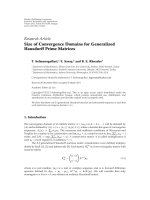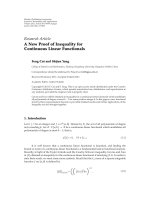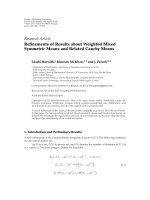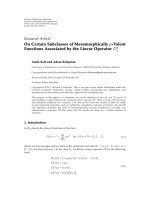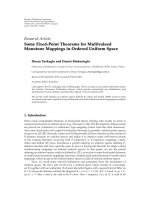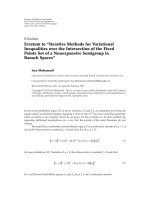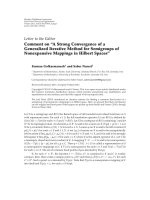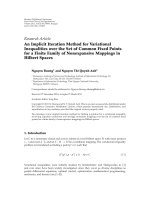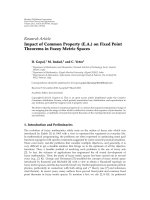Hindawi Publishing Corporation Journal of Inequalities and Applications Volume 2011, Article ID pot
Bạn đang xem bản rút gọn của tài liệu. Xem và tải ngay bản đầy đủ của tài liệu tại đây (540.12 KB, 16 trang )
Hindawi Publishing Corporation
Journal of Inequalities and Applications
Volume 2011, Article ID 401913, 16 pages
doi:10.1155/2011/401913
Research Article
On Certain Subclasses o f Meromorphically p-Valent
Functions Associated by the Linear Operator D
n
λ
Amin Saif and Adem Kılıc¸man
Department of Mathematics, University Putra Malaysia, 43400 UPM, Serdang, Selangor, Malaysia
Correspondence should be addressed to Adem K ılıc¸man,
Received 26 July 2010; Accepted 28 February 2011
Academic Editor: Jong Kim
Copyright q 2011 A. Saif and A. Kılıc¸man. This is an open access article distributed under the
Creative Commons Attribution License, which permits unrestricted use, distribution, and
reproduction in any medium, provided the original work is properly cited.
The purpose of this paper is to introduce two novel subclasses Γ
λ
n, α, β and Γ
∗
λ
n, α, β of
meromorphic p-valent functions by using the linear operator D
n
λ
. T hen we prove the necessary
and sufficient conditions for a function f in order to be in the new classes. Further we study
several important properties such as coefficients inequalities, inclusion properties, the growth
and distortion theorems, the radii of meromorphically p-valent starlikeness, convexity, and
subordination properties. We also prove that the results are sharp for a certain subclass of
functions.
1. Introduction
Let Σ
p
denote the class of functions of the form
f
z
z
−p
∞
kp1
a
k
z
k
a
k
≥ 0; p ∈ N
{
1, 2,
}
,
1.1
which are meromorphic and p-valent in the punctured unit disc U
∗
{z ∈ C :0< |z| < 1}
U −{0}.Forthefunctionsf in the class Σ
p
, we define a linear operator D
n
λ
by the following
form:
D
λ
f
z
1 pλ
f
z
λzf
z
,
λ ≥ 0
,
D
0
λ
f
z
f
z
,
D
1
λ
f
z
D
λ
f
z
,
D
2
λ
f
z
D
λ
D
1
λ
f
z
,
1.2
2 Journal of Inequalities and Applications
and in general for n 0, 1, 2, ,wecanwrite
D
n
λ
f
z
1
z
p
∞
kp1
1 pλ kλ
n
a
k
z
k
,
n ∈ N
0
N ∪
{
0
}
; p ∈ N
.
1.3
Then we can observe easily that for f ∈ Σ
p
,
zλ
D
n
λ
f
z
D
n1
λ
f
z
−
1 pλ
D
n
λ
f
z
,
p ∈ N; n ∈ N
0
.
1.4
Recall 1, 2 that a function f ∈ Σ
p
is said to be meromorphically starlike of order α if it is
satisfying the following condition:
Re
−
zf
z
f
z
>α,
z ∈ U
∗
,
1.5
for some α 0
α<1. Similarly recall 3 afunctionf ∈ Σ
p
is said to be meromorphically
convex of order α if it is satisfying the following condition:
Re
−1 −
zf
z
f
z
>α,
z ∈ U
∗
for some α
0 ≤ α<1
.
1.6
Let Σ
p
α be a subclass of Σ
p
consisting the functions which satisfy the following inequality:
Re
−
z
D
n
λ
f
z
D
n
λ
f
z
>pα,
z ∈ U
∗
; α ≥ 0
.
1.7
In the following definitions, we will define subclasses Γ
λ
n, α, β and Γ
∗
λ
n, α, β by using the
linear operator D
n
λ
.
Definition 1.1. For fixed parameters α ≥ 0, 0 ≤ β<1, the meromorphically p-valent function
fz ∈ Σ
p
α will be in the class Γ
λ
n, α, β if it satisfies the following inequality:
Re
−
z
D
n
λ
f
z
p
D
n
λ
f
z
≥ α
z
D
n
λ
f
z
p
D
n
λ
f
z
1
β,
n ∈ N
0
.
1.8
Definition 1.2. For fixed parameters α ≥ 1/2 β;0≤ β<1, the meromorphically p-valent
function fz ∈ Σ
p
α will be in the class Γ
∗
λ
n, α, β if it satisfies the following inequality:
z
D
n
λ
f
z
p
D
n
λ
f
z
α αβ
≤ Re
−
z
D
n
λ
f
z
p
D
n
λ
f
z
α − αβ, ∀
n ∈ N
0
.
1.9
Journal of Inequalities and Applications 3
Meromorphically multivalent functions have been extensively studied by several authors, see
for example, Aouf 4–6, Joshi and Srivastava 7,Mogra8, 9,Owaetal.10,Srivastava
et al. 11, Raina and Srivastava 12, Uralegaddi and Ganigi 13, Uralegaddi and Somanatha
14, and Ya ng 15. Similarly, in 16, some new subclasses of meromorphic functions in the
punctured unit disk was considered.
In 17, similar results were proved by using the p-valent functions that satisfy the
following differential subordinations:
z
I
p
r, λ
f
z
j1
p − j
I
p
r, λ
f
z
j
≺
a
aB
A − B
β
z
a
1 Bz
1.10
and studied the related coefficients inequalities with β complex number.
This paper is organized as follows. It consists of four sections. Sections 2 and 3
investigate the various important properties and characteristics of the classes Γ
λ
n, α, β and
Γ
∗
λ
n, α, β by giving the necessary and sufficient conditions. Further we study the growth
and distortion theorems and determine the radii of meromorphically p-valent starlikeness
of order μ 0 ≤ μ<p and meromorphically p-valent convexity of order μ 0 ≤ μ<p.In
Section 4 we give some results related to the subordination properties.
2. Properties of the Class Γ
λ
n, α, β
We begin by giving the necessary and sufficient conditions for functions f in order to be in
the class Γ
λ
n, α, β.
Lemma 2.1 see 2. Let
R
a
⎧
⎪
⎪
⎪
⎪
⎪
⎨
⎪
⎪
⎪
⎪
⎪
⎩
a −
α β
1 α
, for a ≤ 1
1 − β
α
1 α
,
1 − a
2
1 − α
2
− 2
1 − β
1 − a
, for a ≥ 1
1 − β
α
1 α
.
2.1
Then
{
w :
|
w − a
|
≤ R
a
}
⊆
w :Re
w
≥ α
|
w − 1
|
β
. 2.2
Theorem 2.2. Let f ∈ Σ
p
.Thenf is in the class Γ
λ
n, α, β if and only if
∞
kp1
p
α β
k
1 α
kλ pλ 1
n
a
k
≤ p
1 − β
α ≥ 0; 0 ≤ β<1; p ∈ N; n ∈ N
0
.
2.3
4 Journal of Inequalities and Applications
Proof. Suppose that f ∈ Γ
λ
n, α, β. Then by the inequalities 1.3 and 1.8,wegetthat
Re
−
z
D
n
λ
f
z
p
D
n
λ
f
z
≥ α
z
D
n
λ
f
z
p
D
n
λ
f
z
1
β.
2.4
That is,
Re
1 −
∞
kp1
k/p
kλ pλ 1
n
a
k
z
kp
1
∞
kp1
kλ pλ 1
n
a
k
z
kp
≥ α
∞
kp1
k/p
1
kλ pλ 1
n
a
k
z
kp
1
∞
kp1
kλ pλ 1
n
a
k
z
kp
β
≥ Re
α ·
∞
kp1
k/p
1
kλ pλ 1
n
a
k
z
kp
1
∞
kp1
kλ pλ 1
n
a
k
z
kp
β
Re
β
∞
kp1
α
k/p
1
β
kλ pλ 1
n
a
k
z
kp
1
∞
kp1
kλ pλ 1
n
a
k
z
kp
,
2.5
that is,
Re
p
1 − β
−
∞
kp1
k kα pα pβ
kλ pλ 1
n
a
k
z
kp
1
∞
kp1
kλ pλ 1
n
a
k
z
kp
≥ 0. 2.6
Taking z to be real and putting z → 1
−
through real values, then the inequality 2.6 yields
p
1 − β
−
∞
kp1
k kα pα pβ
kλ pλ 1
n
a
k
1
∞
kp1
kλ pλ 1
n
a
k
≥ 0, 2.7
which leads us at once to 2.3.
In order to prove the converse, suppose that the inequality 2.3 holds true. In
Lemma 2.1,since1 ≤ 1 1 − β/α1 α,puta 1. Then for p ∈ N and n ∈ N
0
,let
w
np
−zD
n
λ
fz
/pD
n
λ
fz.Ifweletz ∈ ∂U
∗
{z ∈ C : |z| 1},wegetfromthe
inequalities 1.3 and 2.3 that |w
np
− 1|≤R
1
. Thus by Lemma 2.1 above, we ge that
Re
−
z
D
n
λ
f
z
p
D
n
λ
f
z
− 1
Re
w
np
≥ α
w
np
− 1
β α
−
z
D
n
λ
f
z
p
D
n
λ
f
z
− 1
β
α
z
D
n
λ
f
z
p
D
n
λ
f
z
1
β,
α ≥ 0; 0 ≤ β<1; p ∈ N; n ∈ N
0
.
2.8
Therefore by the maximum modulus theorem, we obtain f ∈ Γ
λ
n, α, β.
Journal of Inequalities and Applications 5
Corollary 2.3. If f ∈ Γ
λ
n, α, β,then
a
k
≤
p
1 − β
p
α β
k
1 α
kλ pλ 1
n
,
α ≥ 0; 0 ≤ β<1; p ∈ N; n ∈ N
0
.
2.9
The result is sharp for the function fz given by
f
z
z
−p
∞
kp1
p
1 − β
p
α β
k
1 α
kλ pλ 1
n
z
k
,
α ≥ 0; 0 ≤ β<1; p ∈ N; n ∈ N
0
.
2.10
Theorem 2.4. The class Γ
λ
n, α, β is closed under convex linear combinations.
Proof. Suppose the function
f
z
z
−p
∞
kp1
a
k
z
k,j
a
k,j
≥ 0; j 1, 2; p ∈ N
,
2.11
be in the class Γ
λ
n, α, β.Itissufficient to show that the function hz defined by
h
z
1 − δ
f
1
z
δf
2
z
0 ≤ δ ≤ 1
, 2.12
is also in the class Γ
λ
n, α, β.Since
h
z
z
−p
∞
kp1
1 − δ
a
k,1
δa
k,2
z
k,j
,
0 ≤ δ ≤ 1
,
2.13
and by Theorem 2.2,wegetthat
∞
kp1
p
α β
k
1 α
kλ pλ 1
n
1 − δ
a
k,1
δa
k,2
∞
kp1
1 − δ
p
α β
k
1 α
kλ pλ 1
n
a
k,1
∞
kp1
δ
p
α β
k
1 α
kλ pλ 1
n
a
k,2
≤
1 − δ
p
1 − β
δp
1 − β
p
1 − β
,
α ≥ 0; 0 ≤ β<1; p ∈ N; n ∈ N
0
.
2.14
Hence f ∈ Γ
λ
n, α, β.
The following are the growth and distortion theorems for the class Γ
λ
n, α, β.
6 Journal of Inequalities and Applications
Theorem 2.5. If f ∈ Γ
λ
n, α, β,then
p m − 1
!
p − 1
!
−
1 − β
2α β 1
p 1
n−1
·
p!2
−n
p − m
!
r
2p
r
−pm
≤
f
m
z
≤
p m − 1
!
p − 1
!
1 − β
2α β 1
p 1
n−1
·
p!2
−n
p − m
!
r
2p
r
−pm
0 <
|
z
|
r<1; α ≥ 0; 0 ≤ β<1; p ∈ N; n, m ∈ N
0
; p>m
.
2.15
The result is sharp for the function f given by
f
z
z
−p
∞
kp1
1 − β
2α β 1
2p 2
n
z
p
,
n ∈ N
0
; p ∈ N
.
2.16
Proof. From Theorem 2.2,wegetthat
p
2α β 1
2p 2
n
p 1
!
∞
kp1
k!a
k
≤
∞
kp1
p
α β
k
1 α
kλ pλ 1
n
a
k
≤ p
1 − β
,
2.17
that is,
∞
kp1
k!a
k
≤
p
1 − β
p 1
!
p
2α β 1
2p 2
n
1 − β
p!2
−n
2α β 1
p 1
n−1
.
2.18
By the differentiating the function f in the form 1.1 m times with respect to z,wegetthat
f
m
z
−1
m
p m − 1
!
p − 1
!
z
−pm
∞
kp1
k!
k − m
!
a
k
z
k−m
,
m ∈ N
0
; p ∈ N
2.19
and Theorem 2.5 follows easily from 2.18 and 2.19. Finally, it is easy to see that the bounds
in 2.15 are attained for the function f given by 2.18.
Next we determine the radii of meromorphically p-valent s tarlikeness of order μ 0 ≤
μ<p and meromorphically p-valent convexity of order μ 0 ≤ μ<p for the class Γ
λ
n, α, β.
Theorem 2.6. If f ∈ Γ
λ
n, α, β,thenf is meromorphically p-valent starlike of order μ0 ≤ μ<1
in the disk |z| <r
1
,thatis,
Re
−
zf
z
f
z
>μ
0 ≤ μ<p;
|
z
|
<r
1
; p ∈ N
,
2.20
Journal of Inequalities and Applications 7
where
r
1
inf
k≥p1
p − μ
p
α β
k
1 α
kλ pλ 1
n
p
k μ
1 − β
1/kp
.
2.21
Proof. By the form 1.1,wegetthat
zf
z
/f
z
p
zf
z
/f
z
− p 2μ
∞
kp1
k p
a
k
z
k
2
p − μ
z
−p
∞
kp1
k − p 2μ
a
k
z
k
≤
∞
kp1
k p
|
z
|
k
2
p − μ
a
k
|
z
|
−p
∞
kp1
k − p 2μ
a
k
|
z
|
k
∞
kp1
k p
a
k
|
z
|
kp
2
p − μ
∞
kp1
k − p 2μ
a
k
|
z
|
kp
.
2.22
Then the following incurability
zf
z
/f
z
p
zf
z
/f
z
− p 2μ
≤ 1,
0 ≤ μ<p; p ∈ N
2.23
also holds if
∞
kp1
k μ
p − μ
a
k
|
z
|
kp
≤ 1,
0 ≤ μ<p; p ∈ N
.
2.24
Then by Corollary 2.3 the inequality 2.24 will be true if
k μ
p − μ
|
z
|
kp
≤
p
α β
k
1 α
kλ pλ 1
n
p
1 − β
,
0 ≤ μ<p; p ∈ N
,
2.25
that is,
|
z
|
kp
≤
p − μ
p
α β
k
1 α
kλ pλ 1
n
p
k μ
1 − β
,
0 ≤ μ<p; p ∈ N
.
2.26
Therefore the inequality 2.26 leads us to the disc |z| <r
1
,wherer
1
is given by the form
2.21.
Theorem 2.7. If f ∈ Γ
λ
n, α, β,thenf is meromorphically p-valent convex of order μ 0 ≤ μ<1
in the disk |z| <r
2
,thatis,
Re
−1 −
zf
z
f
z
>μ
0 ≤ μ<p;
|
z
|
<r
2
; p ∈ N
,
2.27
8 Journal of Inequalities and Applications
where
r
2
inf
k≥p1
p − μ
α β
k
1 α
kλ pλ 1
n
k
k μ
1 − β
1/kp
.
2.28
Proof. By the form 1.1,wegetthat
1
zf
z
/f
z
p
1
zf
z
/f
z
− p 2μ
∞
kp1
k
k p
a
k
z
k
2p
p − μ
z
−p
∞
kp1
k
k − p 2μ
a
k
z
k
≤
∞
kp1
k
k p
|
z
|
k
2p
p − μ
a
k
|
z
|
−p
∞
kp1
k
k − p 2μ
a
k
|
z
|
k
∞
kp1
k
k p
a
k
|
z
|
kp
2p
p − μ
∞
kp1
k
k − p 2μ
a
k
|
z
|
kp
.
2.29
Then the following incurability:
1
zf
z
/f
z
p
1
zf
z
/f
z
− p 2μ
≤ 1,
0 ≤ μ<p; p ∈ N
2.30
will hold if
∞
kp1
k
k μ
p
p − μ
a
k
|
z
|
kp
≤ 1,
0 ≤ μ<p; p ∈ N
.
2.31
Then by Corollary 2.3 the inequality 2.31 will be true if
k
k μ
p
p − μ
|
z
|
kp
≤
p
α β
k
1 α
kλ pλ 1
n
p
1 − β
,
0 ≤ μ<p; p ∈ N
,
2.32
that is,
|
z
|
kp
≤
p − μ
α β
k
1 α
kλ pλ 1
n
k
k μ
1 − β
,
0 ≤ μ<p; p ∈ N
.
2.33
Therefore the inequality 2.33 leads us to the disc |z| <r
2
,wherer
2
is given by the form
2.28.
3. Properties of the Class Γ
∗
λ
n, α, β
We first give the necessary and sufficient conditions for functions f in order to be in the class
Γ
∗
λ
n, α, β.
Journal of Inequalities and Applications 9
Lemma 3.1 see 2. Let μ>δand
R
a
⎧
⎨
⎩
a − δ, for a ≤ 2μ δ,
2
μ
a − μ − δ
, for a ≥ 2μ δ.
3.1
Then
{
w :
|
w − a
|
≤ R
a
}
⊆
w :
w −
μ δ
≤ Re
w μ − δ
. 3.2
Lemma 3.2. Let α ≥ 0 and 0 ≤ β<1
R
a
⎧
⎨
⎩
a − αβ, for a ≤ 2α αβ,
2
α
a − α − αβ
, for a ≥ 2α αβ.
3.3
Then
{
w :
|
w − a
|
≤ R
a
}
⊆
w :
w −
α αβ
≤ Re
w α − αβ
. 3.4
Proof. Since α ≥ 0and0≤ β<1, then α>αβ.TheninLemma3.1,putμ α and δ αβ.
Theorem 3.3. Let f ∈ Σ
p
.Thenf is in the class Γ
∗
λ
n, α, β if and only if
∞
kp1
k pαβ
kλ pλ 1
n
a
k
≤ p
1 − αβ
α ≥
1
2 β
;0≤ β<1; p ∈ N; n ∈ N
0
.
3.5
Proof. Suppose that f ∈ Γ
∗
λ
n, α, β. Then by the inequality 1.9,wegetthat
z
D
n
λ
f
z
p
D
n
λ
f
z
α αβ
≤ Re
−
z
D
n
λ
f
z
p
D
n
λ
f
z
α − αβ.
3.6
That is,
Re
z
D
n
λ
f
z
p
D
n
λ
f
z
α αβ
≤
z
D
n
λ
f
z
p
D
n
λ
f
z
α αβ
≤ Re
−
z
D
n
λ
f
z
p
D
n
λ
f
z
α − αβ,
3.7
10 Journal of Inequalities and Applications
that is,
Re
2z
D
n
λ
f
z
p
D
n
λ
f
z
2αβ
≤ 0.
3.8
Hence by the inequality 1.3,
Re
−2p
1 − αβ
∞
kp1
2
k pαβ
kλ pλ 1
n
a
k
z
kp
p
∞
kp1
p
kλ pλ 1
n
a
k
z
kp
≤ 0. 3.9
Taking z to be real and putting z → 1
−
through real values, then the inequality 3.9 yields
−2p
1 − αβ
∞
kp1
2
k pαβ
kλ pλ 1
n
a
k
p
∞
kp1
p
kλ pλ 1
n
a
k
≤ 0, 3.10
which leads us at once to 3.5.
In order to prove the converse, consider that the inequality 3.5 holds true. In
Lemma 3.2 above, since α>αβand α ≥ 1/2 β,thatis,1 ≤ 2α αβ,wecanput
a 1. Then for p ∈ N and n ∈ N
0
,letw
np
−zD
n
λ
fz
/pD
n
λ
fz.Now,ifwelet
z ∈ ∂U
∗
{z ∈ C : |z| 1}, we get from the inequalities 1.3 and 3.5 that |w
np
− 1|≤R
1
.
Thus by Lemma 3.2 above, we ge that
z
D
n
λ
f
z
p
D
n
λ
f
z
α αβ
−
z
D
n
λ
f
z
p
D
n
λ
f
z
−
α αβ
w −
α αβ
≤ Re
w α − αβ
Re
{
w
}
α − αβ
−
z
D
n
λ
f
z
p
D
n
λ
f
z
α − αβ,
α ≥
1
2 β
;0≤ β<1; p ∈ N; n ∈ N
0
.
3.11
Therefore by the maximum modulus theorem, we obtain f ∈ Γ
∗
λ
n, α, β.
Corollary 3.4. If f ∈ Γ
∗
λ
n, α, β,then
a
k
≤
p
1 − αβ
k pαβ
kλ pλ 1
n
α ≥
1
2 β
;0≤ β<1; p ∈ N; n ∈ N
0
.
3.12
Journal of Inequalities and Applications 11
The result is sharp for the function fz given by
f
z
z
−p
∞
kp1
p
1 − αβ
k pαβ
kλ pλ 1
n
z
k
α ≥
1
2 β
;0≤ β<1; p ∈ N; n ∈ N
0
.
3.13
Theorem 3.5. The class Γ
∗
λ
n, α, β is closed under convex linear combinations.
Proof. This proof is similar as the proof of Theorem 2.4.
The following are the growth and distortion theorems for the class Γ
∗
λ
n, α, β.
Theorem 3.6. If f ∈ Γ
∗
λ
n, α, β,then
p m − 1
!
p − 1
!
−
1 − αβ
1 αβ
p 1
n−1
·
p!2
−n
p − m
!
r
2p
r
−pm
≤
f
m
z
≤
p m − 1
!
p − 1
!
1 − αβ
1 αβ
p 1
n−1
·
p!2
−n
p − m
!
r
2p
r
−pm
0 <
|
z
|
r<1; α ≥
1
2 β
;0≤ β<1; p ∈ N; n, m ∈ N
0
; p>m
.
3.14
The result is sharp for the function f given by
f
z
z
−p
∞
kp1
1 − αβ
1 αβ
2p 2
n
z
p
,
n ∈ N
0
; p ∈ N
.
3.15
Next we determine the radii of meromorphically p-valent starlikeness of order μ 0 ≤ μ<p
and meromorphically p-valent convexity of order μ 0 ≤ μ<p for the class Γ
∗
λ
n, α, β.
Theorem 3.7. If f ∈ Γ
∗
λ
n, α, β,thenf is meromorphically p-valent starlike of order μ 0 ≤ μ<1
in the disk |z| <r
1
,thatis,
Re
−
zf
z
f
z
>μ
0 ≤ μ<p;
|
z
|
<r
1
; p ∈ N
,
3.16
where
r
1
inf
k≥p1
p − μ
k pαβ
kλ pλ 1
n
p
k μ
1 − αβ
1/kp
.
3.17
Proof. This proof is similar to the proof of Theorem 2.6.
12 Journal of Inequalities and Applications
Theorem 3.8. If f ∈ Γ
∗
λ
n, α, β,thenf is meromorphically p-valent convex of order μ 0 ≤ μ<1
in the disk |z| <r
2
,thatis,
Re
−1 −
zf
z
f
z
>μ
0 ≤ μ<p;
|
z
|
<r
2
; p ∈ N
,
3.18
where
r
2
inf
k≥p1
p − μ
k pαβ
kλ pλ 1
n
k
k μ
1 − αβ
1/kp
.
3.19
Proof. This proof is similar to the proof of Theorem 2.7.
4. Subordination Properties
If f and g are analytic functions in U, we say that f is subordinate to g, written symbolically
as follows:
f ≺ g in U or f
z
≺ g
z
z ∈ U
4.1
if there exists a function w which is analytic in U with
w
0
0,
|
w
z
|
< 1
z ∈ U
, 4.2
such that
f
z
g
w
z
z ∈ U
. 4.3
Indeed it is known that
f
z
≺ g
z
z ∈ U
⇒
f
0
g
0
,f
U
⊂ g
U
. 4.4
In particular, if the function g is univalent in U we have the following equivalence see 18:
f
z
≺ g
z
z ∈ U
⇐⇒ f
0
g
0
,f
U
⊂ g
U
. 4.5
Let φ : C
2
→ C be a function and let h be univalent in U.IfJ is analytic function in U and
satisfied the differential subordination φJz,J
z ≺ hz then J is called a solution of the
differential subordination φJz,J
z ≺ hz. The univalent function q is called a dominant of
the solution of the differential subordination, J ≺ q.
Journal of Inequalities and Applications 13
Lemma 4.1 see 19. Let qz
/
0 be univalent in U.Letθ and φ be analytic in a domain D
containing qU with φw
/
0 when w ∈ qU.Set
Q
z
zq
z
φ
q
z
,h
z
θ
q
z
Q
z
. 4.6
Suppose that
i Qz is starlike univalent in U,
ii Re{zh
z/Qz} > 0 for z ∈ U.
If J is analytic function in U and
θ
J
z
zJ
z
φ
J
z
≺ θ
q
z
zq
z
φ
q
z
, 4.7
then Jz ≺ qz and q is the best dominant.
Lemma 4.2 see 20. Let w, γ ∈ C and φ is convex and univalent in U with φ01 and
Re{wφzγ} > 0 for all z ∈ U.Ifq is analytic in U with q01 and
q
z
zq
z
wq
z
γ
≺ φ
z
z ∈ U
,
4.8
then qz ≺ φz and φ is the best dominant.
Theorem 4.3. Let qz
/
0 be univalent in U such that zq
z/qz is starlike univalent in U and
Re
1
γ
q
z
zq
z
q
z
−
zq
z
q
z
> 0,
, γ ∈ C, γ
/
0
.
4.9
If f ∈ Σ
p
satisfies the subordination
z
D
n
λ
f
z
D
n
λ
f
z
γ
1
z
D
n
λ
f
z
D
n
λ
f
z
−
z
D
n
λ
f
z
D
n
λ
f
z
≺ q
z
γzq
z
q
z
, 4.10
then zD
n
λ
fz
/D
n
λ
fz ≺ qz and q is the best dominant.
Proof. Our aim is to apply Lemma 4.1. Setting
J
z
z
D
n
λ
f
z
D
n
λ
f
z
−p
∞
kp1
k
kλ pλ 1
n
a
k
z
kp
1
∞
kp1
kλ pλ 1
n
a
k
z
kp
,
n ∈ N
0
; p ∈ N
, 4.11
θww and φwγ/w, γ
/
0. It can be easily observed that J is analytic in U, θ is analytic
in C, φ is analytic in C/{0} and φw
/
0. By computation shows that
zJ
z
J
z
1
z
D
n
λ
f
z
D
n
λ
f
z
−
z
D
n
λ
f
z
D
n
λ
f
z
4.12
14 Journal of Inequalities and Applications
which yields, by 4.10, the following subordination:
J
z
γ
zJ
z
J
z
≺ q
z
γzq
z
q
z
,
4.13
that is,
θ
J
z
zJ
z
φ
J
z
≺ θ
q
z
zq
z
φ
q
z
. 4.14
Now by letting
Q
z
zq
z
φ
q
z
γzq
z
q
z
,
h
z
θ
q
z
Q
z
q
z
γzq
z
q
z
.
4.15
We find Qi starlike univalent in U and that
Re
zh
z
Q
z
Re
1
γ
q
z
zq
z
q
z
−
zq
z
q
z
> 0.
4.16
Hence by Lemma 4.1, zD
n
λ
fz
/D
n
λ
fz ≺ qz and q is the best dominant.
Corollary 4.4. If f ∈ Σ
p
and assume that 4.9 holds, then
1
z
D
n
λ
f
z
D
n
λ
f
z
≺
1 Az
1 Bz
A − B
z
1 Az
1 Bz
4.17
implies that zD
n
λ
fz
/D
n
λ
fz ≺ 1 Az/1 Bz, −1 ≤ B<A≤ 1 and 1 Az/1 Bz
is the best dominant.
Proof. By setting γ 1andqz1 Az/1 Bz in Theorem 4.3,thenwecanobtain
the result.
Corollary 4.5. If f ∈ Σ
p
and assume that 4.9 holds, then
1
z
D
n
λ
f
z
D
n
λ
f
z
≺ e
αz
αz 4.18
implies that zD
n
λ
fz
/D
n
λ
fz ≺ e
αz
, |α| <πand e
αz
is the best dominant.
Proof. By setting γ 1andqze
αz
in Theorem 4.3,where|α| <π.
Journal of Inequalities and Applications 15
Theorem 4.6. Let w, γ ∈ C,andφ be convex and univalent in U with φ01 and Re{wφzγ} >
0 for all z ∈ U.Iff ∈ Σ
p
satisfies the subordination
1 γ
z
D
n
λ
f
z
/
D
n
λ
f
z
−
w/p
1
z
D
n
λ
f
z
/
D
n
λ
f
z
w − γ
p
D
n
λ
f
z
/z
D
n
λ
f
z
≺ φ
z
, 4.19
then −zD
n
λ
fz
/pD
n
λ
fz ≺ φz and φ is the best dominant.
Proof. Our aim is to apply Lemma 4.2. Setting
q
z
−z
D
n
λ
f
z
p
D
n
λ
f
z
p
∞
kp1
k
kλ pλ 1
n
a
k
z
kp
p
∞
kp1
p
kλ pλ 1
n
a
k
z
kp
,
n ∈ N
0
; p ∈ N
. 4.20
It can be easily observed that q is analytic in U and q01. Computation shows that
zq
z
q
z
1
z
D
n
λ
f
z
D
n
λ
f
z
−
z
D
n
λ
f
z
D
n
λ
f
z
4.21
which yields, by 4.19, the following subordination:
q
z
zq
z
wq
z
γ
≺ φ
z
,
z ∈ U
.
4.22
Hence by Lemma 4.2, −zD
n
λ
fz
/pD
n
λ
fz ≺ φz and φ is the best dominant.
Acknowledgments
The authors express their sincere thanks to the referees for their very constructive comments
and suggestions. The authors also acknowledge that this research was partially supported
by the University Putra Malaysia under the Research University Grant Scheme 05-01-09-
0720RU.
References
1 M. K. Aouf and H. M. Hossen, “New criteria for meromorphic p-valent starlike functions,” Tsukuba
Journal of Mathematics, vol. 17, no. 2, pp. 481–486, 1993.
2 S. S. Kumar, V. Ravichandran, and G. Murugusundaramoorthy, “Classes of meromorphic p-valent
parabolic starlike functions with positive coefficients,” The Australian Journal of Mathematical Analysis
and Applications, vol. 2, no. 2, pp. 1–9, 2005.
3 M. Nunokawa and O. P. Ahuja, “On meromorphic starlike and convex functions,” Indian Journal of
Pure and Applied Mathematics, vol. 32, no. 7, pp. 1027–1032, 2001.
4 M. K. Aouf, “Certain subclasses of meromorphically p-valent functions with positive or negative
coefficients,” Mathematical and Computer Modelling, vol. 47, no. 9-10, pp. 997–1008, 2008.
5 M. K. Aouf, “Certain subclasses of meromorphically multivalent functions associated with
generalized hypergeometric function,” Computers & Mathematics with Applications, vol. 55, no. 3, pp.
494–509, 2008.
16 Journal of Inequalities and Applications
6 M. K. Aouf, “On a certain class of meromorphic univalent functions with positive coefficients,”
Rendiconti di Matematica e delle sue Applicazioni. Serie VII, vol. 11, no. 2, pp. 209–219, 1991.
7 S. B. Joshi and H. M. Srivastava, “A certain family of meromorphically multivalent functions,”
Computers & Mathematics with Applications, vol. 38, no. 3-4, pp. 201–211, 1999.
8 M. L. Mogra, “Meromorphic multivalent functions with positive coefficients. I,” Mathematica Japonica,
vol. 35, no. 1, pp. 1–11, 1990.
9 M. L. Mogra, “Meromorphic multivalent functions with positive coefficients. II,” Mathematica Japonica,
vol. 35, no. 6, pp. 1089–1098, 1990.
10 S. Owa, H. E. Darwish, and M. K. Aouf, “Meromorphic multivalent functions with positive and fixed
second coefficients,” Mathematica Japonica, vol. 46, no. 2, pp. 231–236, 1997.
11 H. M. Srivastava, H. M. Hossen, and M. K. Aouf, “A unified presentation of some classes of
meromorphically multivalent functions,” Computers & Mathematics with Applications, vol. 38, no. 11-12,
pp. 63–70, 1999.
12 R. K. Raina and H. M. Srivastava, “A new class of meromorphically multivalent functions with
applications to generalized hypergeometric functions,” Mathematical and Computer Modelling, vol. 43,
no. 3-4, pp. 350–356, 2006.
13 B. A. Uralegaddi and M. D. Ganigi, “Meromorphic multivalent functions with positive coefficients,”
The Nepali Mathematical Sciences Report, vol. 11, no. 2, pp. 95–102, 1986.
14 B. A. Uralegaddi and C. Somanatha, “New criteria for me romorphic starlike univalent functions,”
Bulletin of the Australian Mathematical Society, vol. 43, no. 1 , pp. 137–140, 1991.
15 D. G. Yang, “On new subclasses o f meromorphic p-valent functions,” Journal of Mathematical Research
and Exposition, vol. 15, no. 1, pp. 7–13, 1995.
16 I. Faisal, M. Darus, and A. Kılıc¸man, “New subclasses of meromorphic functions associated with
hadamard product,” in Proceedings of the International Conference on Mathematical Sciences (ICMS ’10),
vol. 1309 of AIP Conference Proceedings, pp. 272–279, 2010.
17 A. Tehranchi and A. Kı
lıc¸man, “On certain classes of p-valent functions by using complex-order and
differential subordination,” International Journal of Mathematics and Mathematical Sciences, vol. 2010,
Article ID 275935, 12 pages, 2010.
18 H. M. Srivastava and S. S. Eker, “Some applications of a subordination theorem for a class of analytic
functions,” Applied Mathematics Letters, vol. 21, no. 4, pp. 394–399, 2008.
19 S. S. Miller and P. T. Mocanu, “Subordinants of differential superordinations,” Complex Variables,vol.
48, no. 10, pp. 815–826, 2003.
20 Z G. Wang, Y. -P. Jiang, and H. M. Srivastava, “Some subclasses of meromorphically multivalent
functions associated with the generalized hypergeometric function,” Computers & Mathematics with
Applications, vol. 57, no. 4, pp. 571–586, 2008.
